Arc Voltage and Current Characteristics in Low-Voltage Direct Current
Abstract
:1. Introduction
2. DC Arc Experiment Method
2.1. Experimental Setup
2.2. Experiment of DC Arc
3. The Experimental Results of DC Breaking Arc
3.1. Analysis of Arc Initiation Threshold Voltage ()
3.2. Analysis of Arc Initiation Threshold Current ()
3.3. Analysis of Relationship between Arc Voltage () and Arc Current () between Electrodes
3.4. Power Analysis between Electrodes at Random Time within Arc Duration
3.5. Arc Extinguishing Threshold Point
4. Conclusions
Author Contributions
Funding
Acknowledgments
Conflicts of Interest
Nomenclature
| VS | Source voltage, |
| IL | Load current, |
| RL | Load resistance, |
| t0 | Separation start time of electrodes, |
| t1 | Arc initiation time, |
| text | Arc extinguishing time, |
| Time between t1 and text | Arc duration time, |
| d0 | Distance when electrodes are connected = 0, |
| d1 | Distance between electrodes at t1, |
| dext | Distance between electrodes at text, |
| Vth | Arc initiation threshold voltage, |
| Ith | Arc initiation threshold current, |
| Varc | Instantaneous arc voltage between electrodes, |
| Iarc | Instantaneous arc current, |
| rarc | Instantaneous arc resistance between electrodes, |
| parc | Instantaneous arc power between electrodes, |
| pmax | Maximum arc power. |
References
- Kim, H. DC distribution systems and circuit breaking technology. J. Korean Inst. Power Electron. 2010, 15, 40–46. [Google Scholar]
- Babasaki, T.; Tanaka, T.; Nozaki, Y.; Aoki, T.; Kurokawa, F. Developing of Higher Voltage Direct-Current Power-Feeding Prototype System. In Proceedings of the INTELEC 2009—31st International Telecommunications Energy Conference, Incheon, Korea, 18–22 October 2009. [Google Scholar]
- Yuba, T.; Baek, S.; Kiryu, K.; Nakamura, A.; Miyazawa, H.; Noritake, M.; Hirose, K. Development of Plug and Socket-outlet for 400 Volts Direct Current Distribution System. In Proceedings of the 8th International Conference on Power Electronics (ECCE Asia), Jeju, Korea, 30 May–3 June 2011. [Google Scholar]
- Lee, S.; Kim, H. Development of DC circuit breaker using magnet arc extinguisher. Trans. Korean Inst. Power Electron. 2012, 17, 21–26. [Google Scholar] [CrossRef]
- Berzak, L.F.; Dorfman, S.E.; Smith, S.P. Paschen′s Law in Air and Noble Gases. Available online: http://www-eng.lbl.gov/~shuman/XENON/REFERENCES&OTHER_MISC/paschen_report.pdf (accessed on 19 September 2018).
- Ayrton, H. The Electric Arc; Electrician: London, UK, 1902. [Google Scholar]
- Nottingham, W.B. A new equation for the static characteristic of the normal electric arc. Trans. Am. Inst. Elect. Eng. 1923, 42, 12–19. [Google Scholar] [CrossRef]
- Van, A.R.; Warrington, C. Reactance relays negligibly affected by arc impedance. Electron. World 1931, 98, 502–505. [Google Scholar]
- Stokes, A.D.; Oppenlander, W.T. Electric arcs in open air. J. Phys. D Appl. Phys. 1991, 24, 26–35. [Google Scholar] [CrossRef]
- Rau, S.H.; Lee, W.J. DC arc model based on 3-D DC arc simulation. IEEE Trans. Ind. Appl. 2016, 52, 5255–5261. [Google Scholar] [CrossRef]
- Kim, Y.J.; Kim, H.S. Modeling for series arc of DC circuit breaker. In Proceedings of the 2017 IEEE 6th International Conference on Renewable Energy Research and Applications (ICRERA), San Diego, CA, USA, 5–8 November 2017. [Google Scholar]
- Ammerman, R.F.; Gammon, T.; Sen, P.K.; Nelson, J.P. DC-arc models and incident-energy calculations. IEEE Trans. Ind. Appl. 2010, 46, 1810–1819. [Google Scholar] [CrossRef]
- Sawa, K.; Tsuruoka, M.; Yamashita, S. Fundamental arc Characteristics at DC Current Interruption of Low Voltage (<500 V). In Proceedings of the 27th International Conference on Electrical Contacts, Dresden, Germany, 22–26 June 2014. [Google Scholar]
- Uriarte, F.M.; Gattozzi, A.L.; Herbst, J.D.; Estes, H.B.; Hotz, T.J.; Kwasinski, A.; Hebner, R.E. A DC arc model for series faults in low voltage microgrids. IEEE Trans. Smart Grid 2012, 3, 2063–2070. [Google Scholar] [CrossRef]

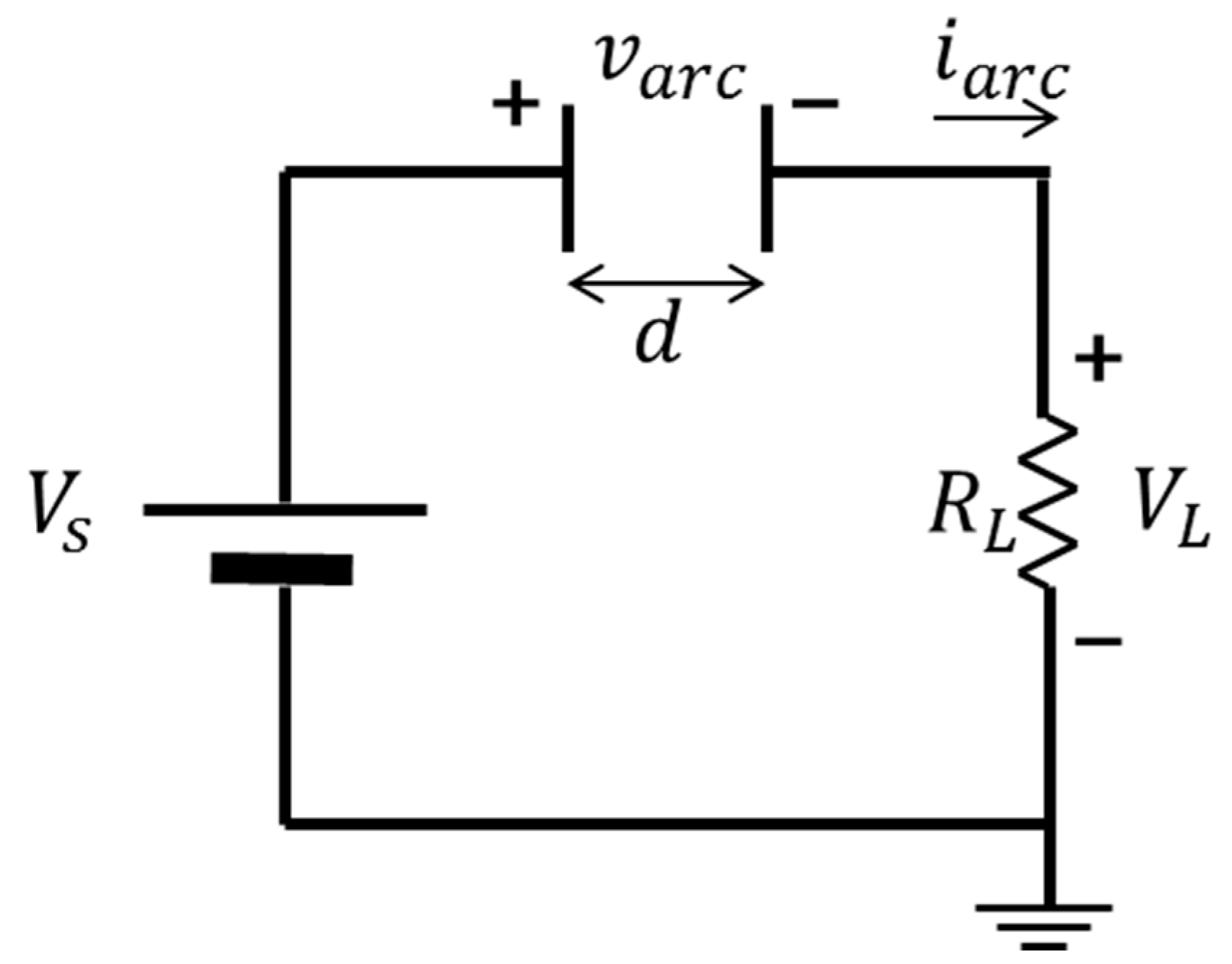


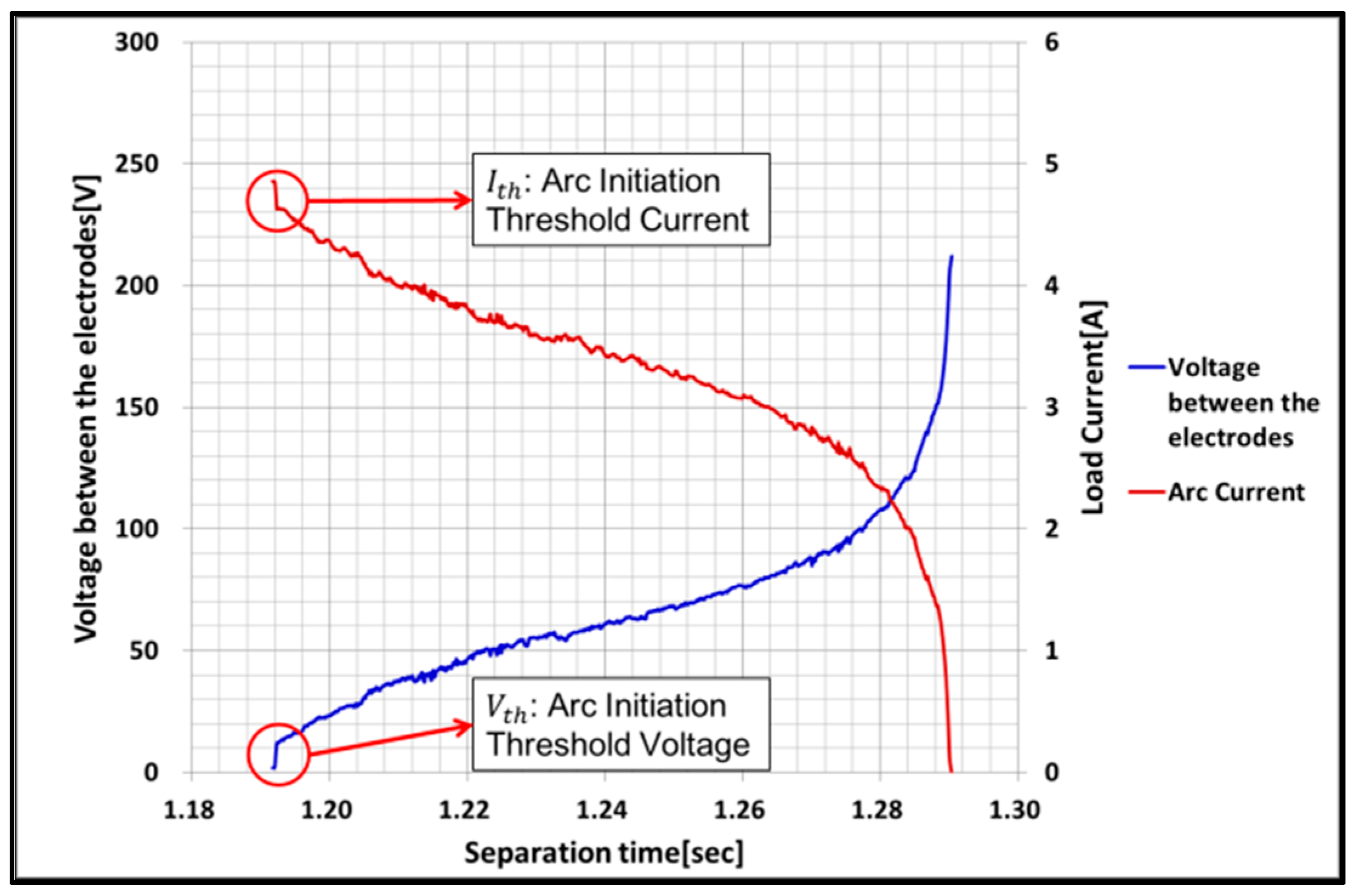
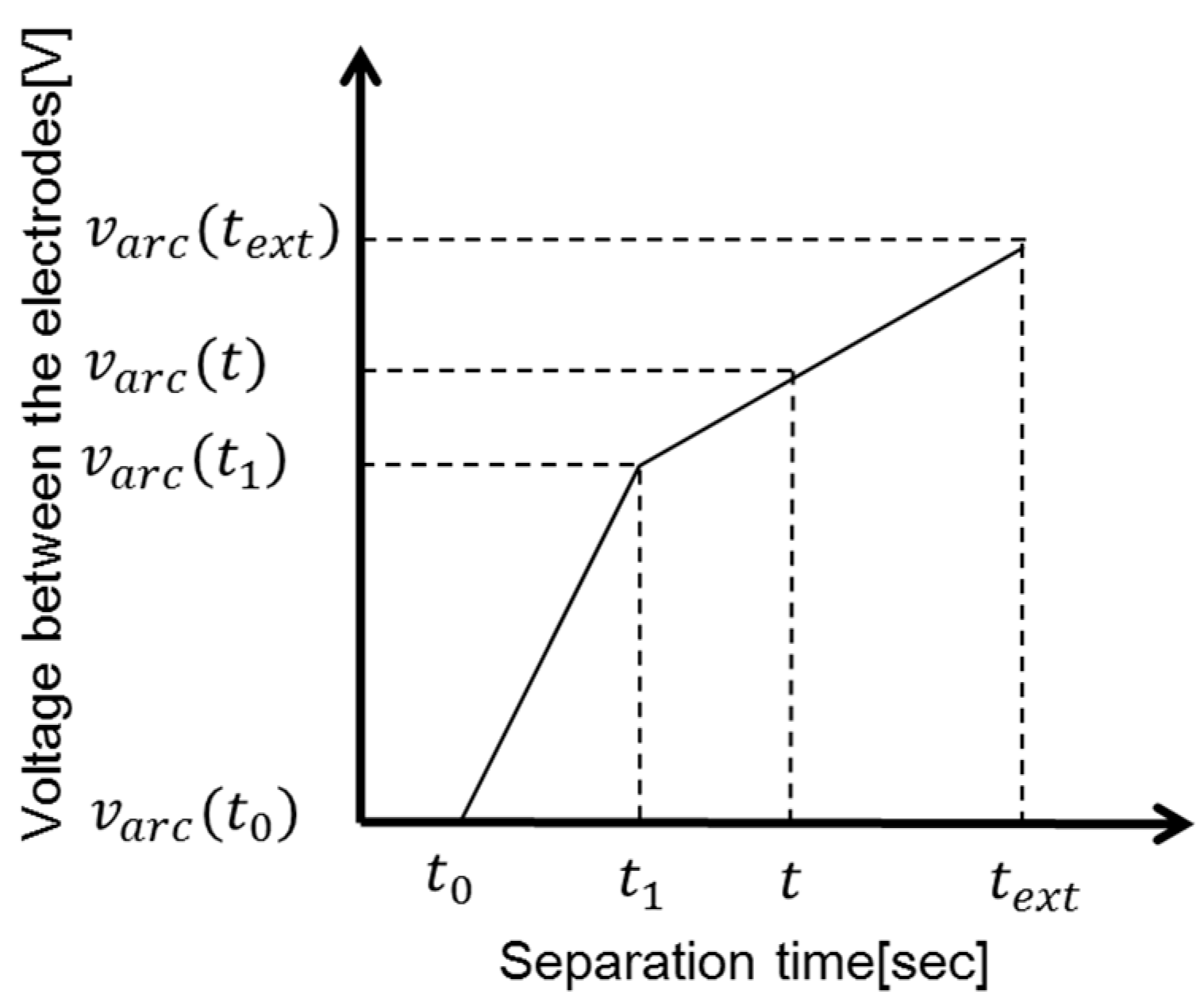
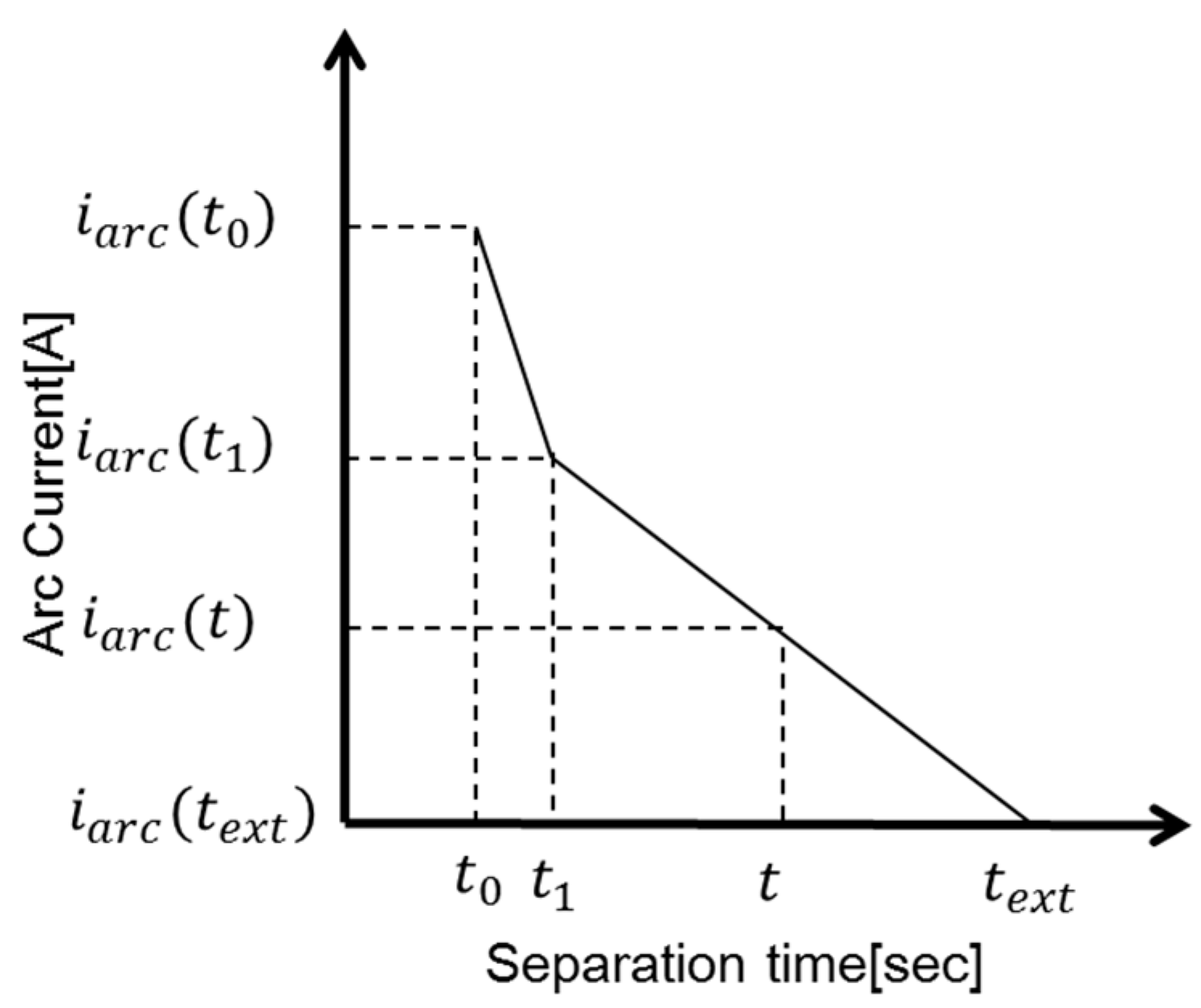

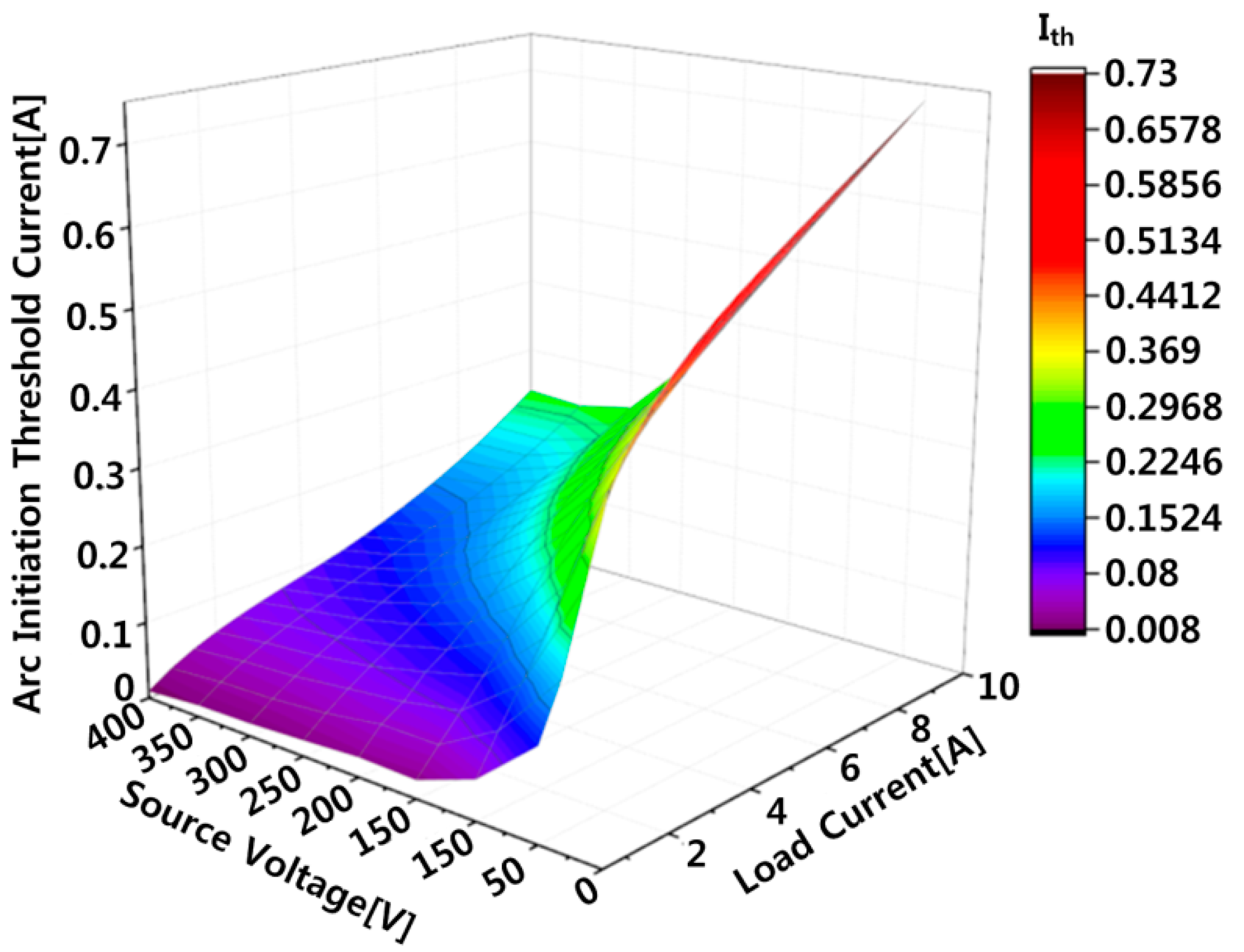
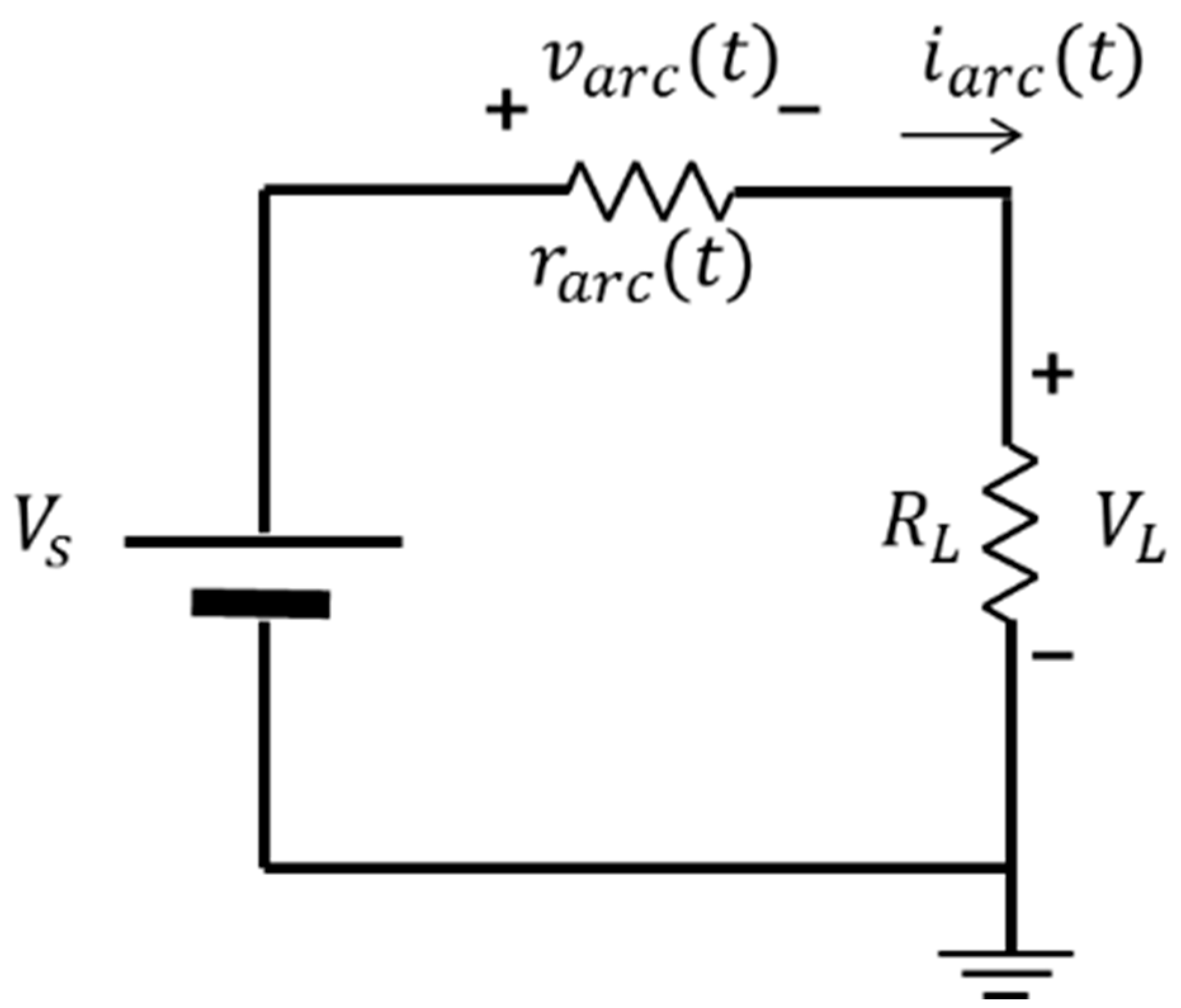
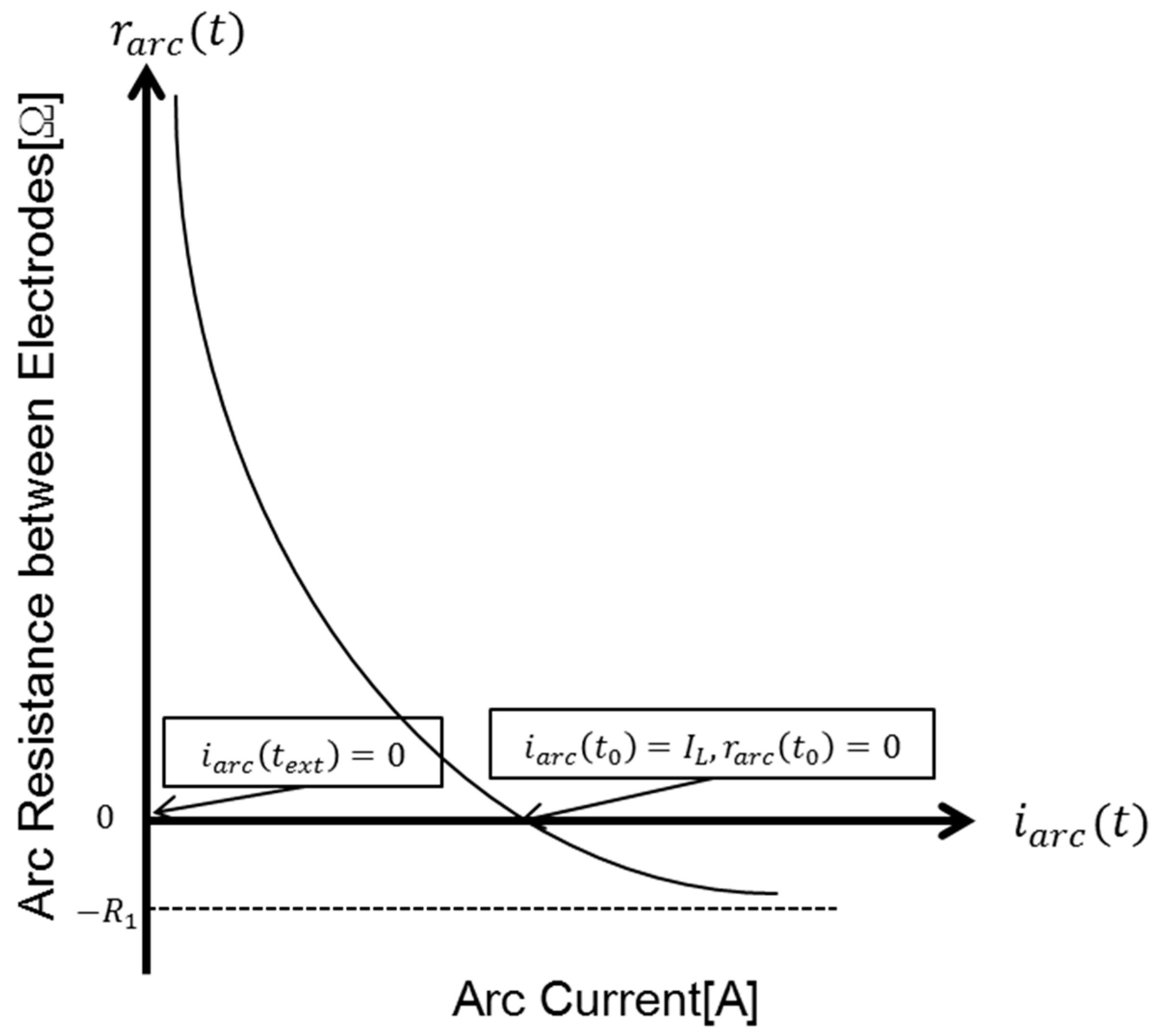

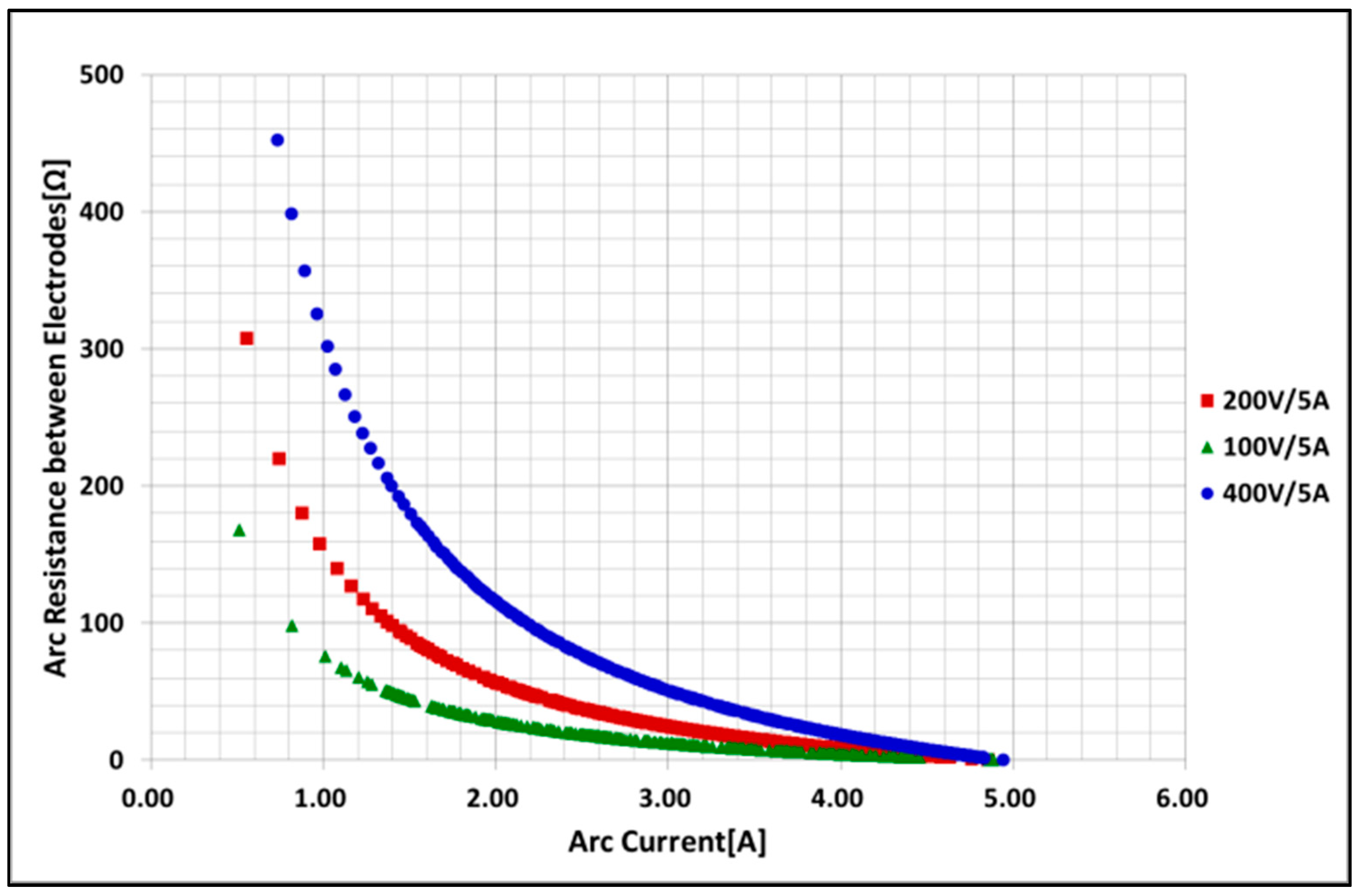
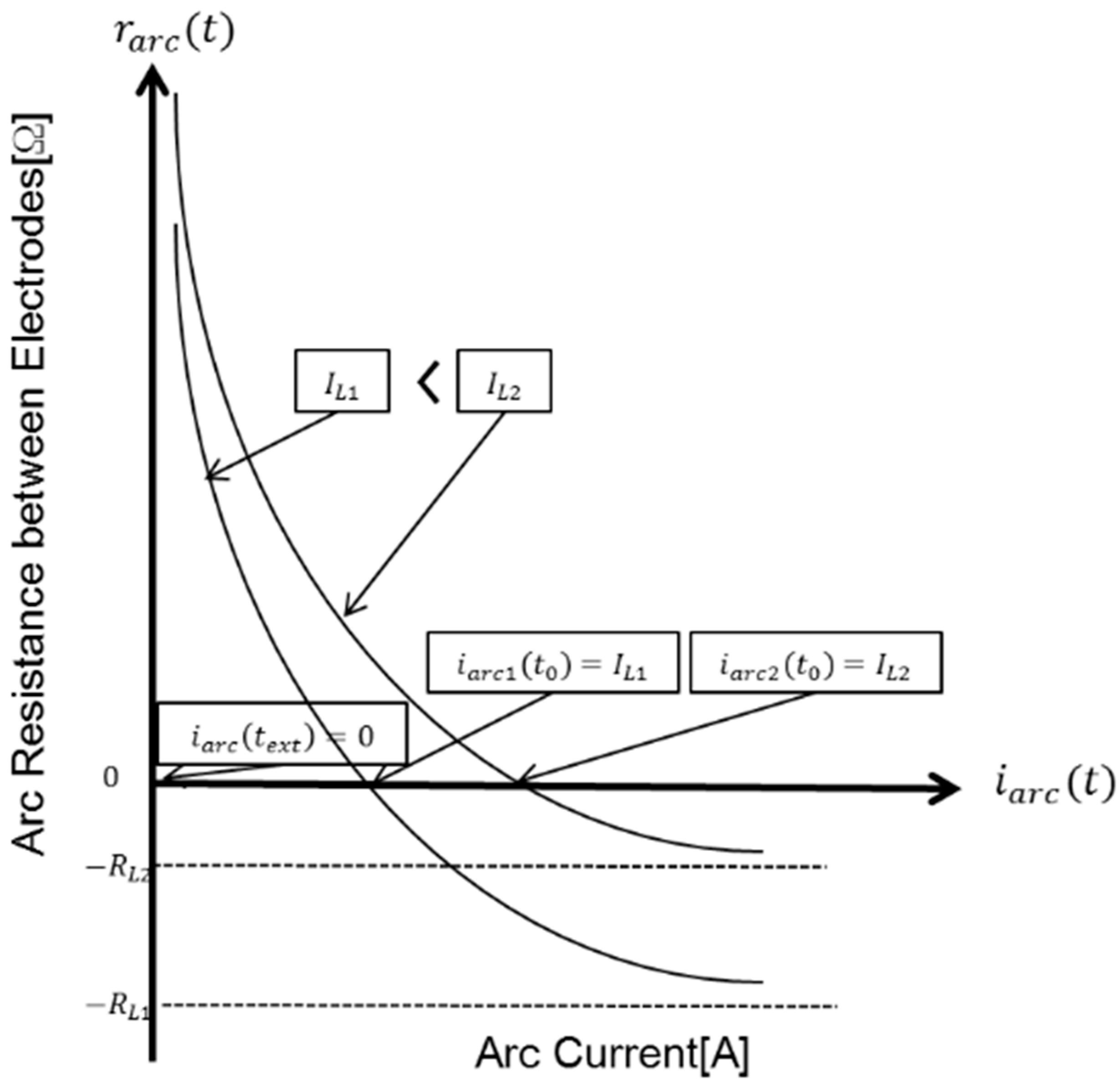

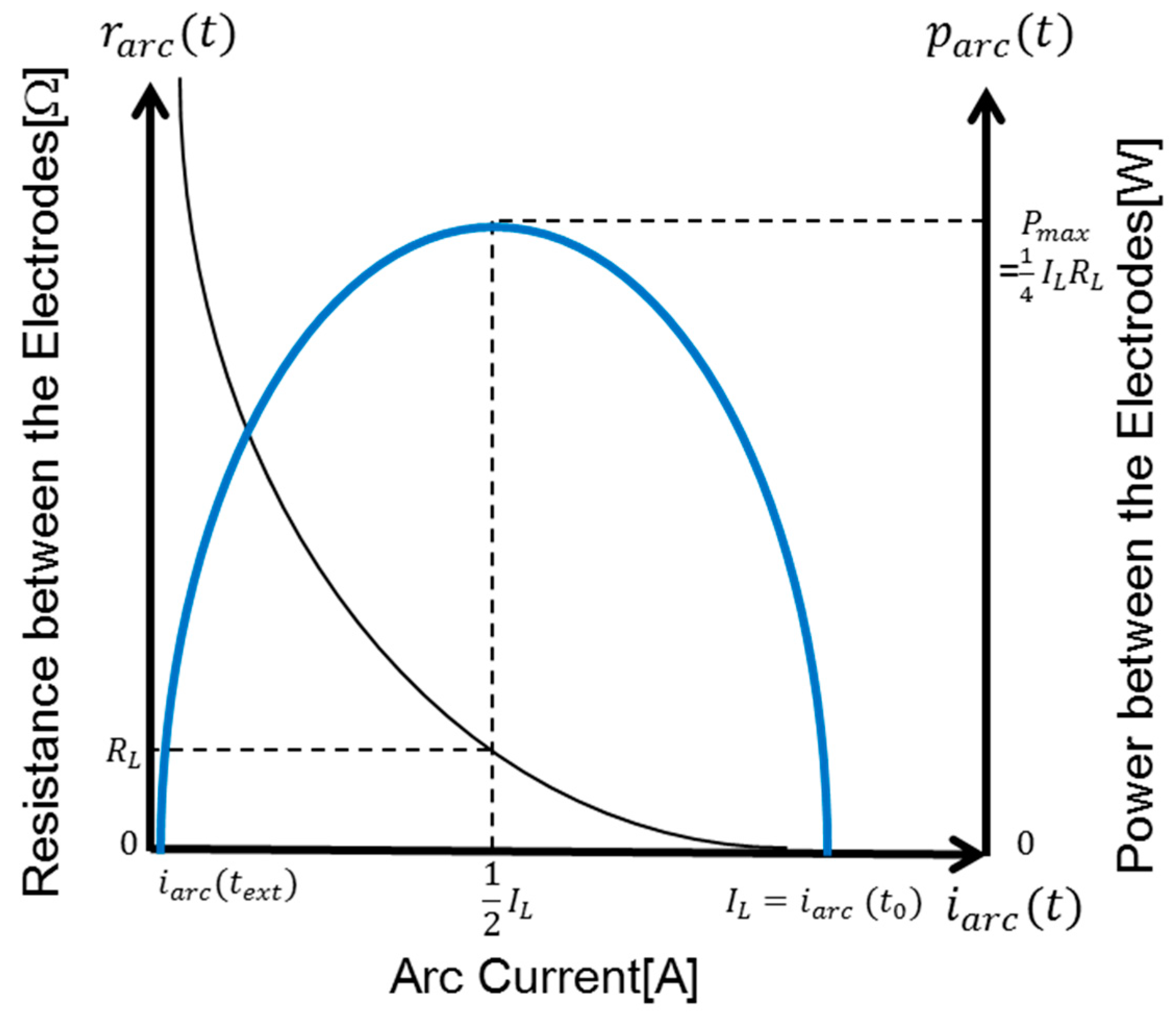
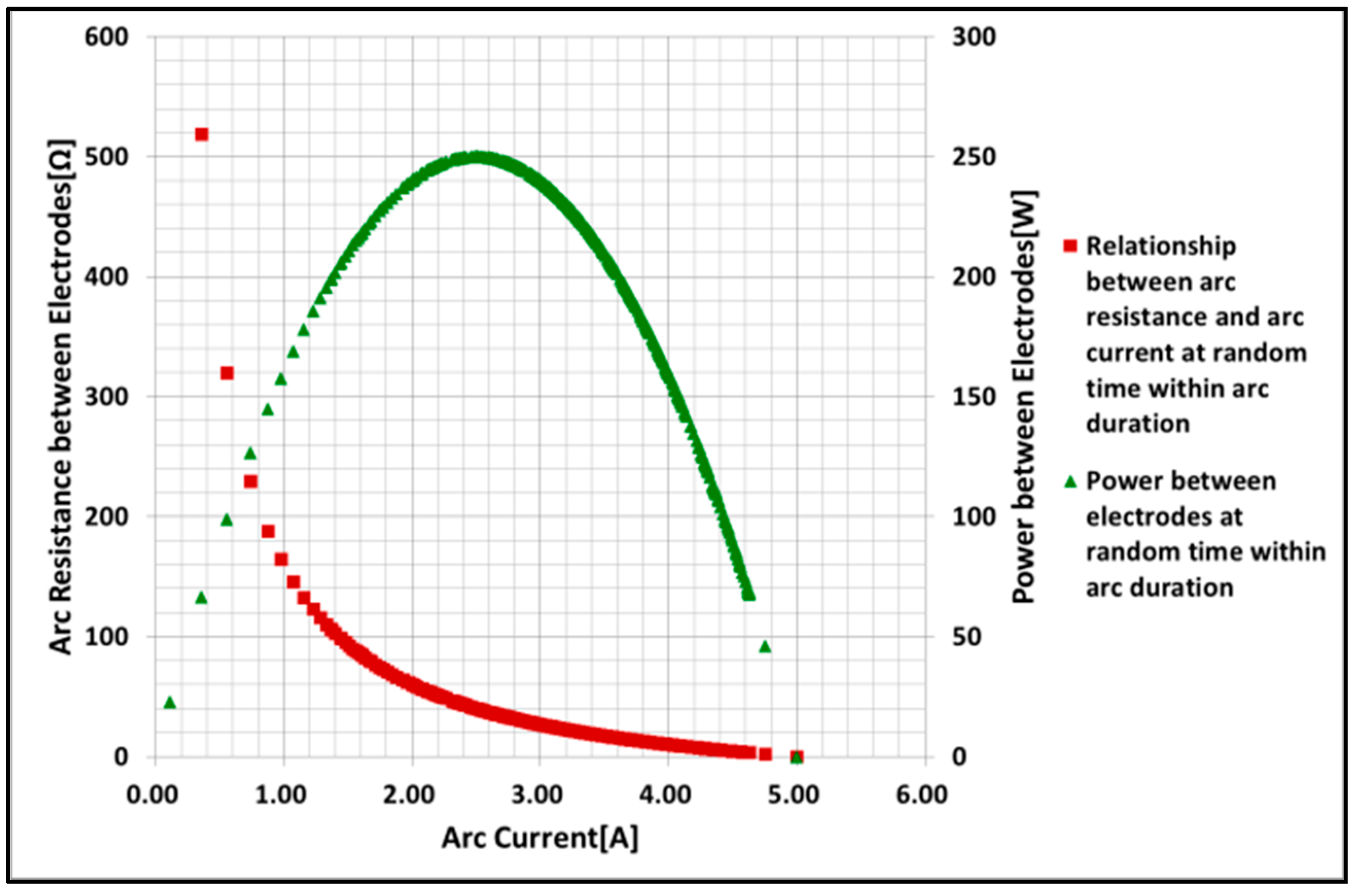

| No. | Experimental Conditions |
|---|---|
| 1 | Circuit Condition: resistive load |
| DC 50 V, 1/2 A | |
| DC 100 V, 0.5/1/2/3/4/5 A | |
| DC 200 V, 0.5/1/1.5/2/2.5/5/10 A | |
| DC 400 V, 1/5/10 A | |
| 2 | Separation Speed: 150 mm/s |
| 3 | Operation Number: 3 times at each condition |
| (Source Voltage) (V) | (Load Current) (A) | (Arc Initiation Threshold Voltage) (V) |
|---|---|---|
| 50 | 1 | 9.56 |
| 50 | 2 | 9.77 |
| 100 | 0.5 | 9.92 |
| 100 | 1 | 9.55 |
| 100 | 2 | 9.60 |
| 100 | 3 | 9.84 |
| 100 | 4 | 9.73 |
| 100 | 5 | 9.60 |
| 200 | 0.5 | 10.28 |
| 200 | 1 | 9.80 |
| 200 | 1.5 | 10.09 |
| 200 | 2 | 9.78 |
| 200 | 2.5 | 9.63 |
| 200 | 5 | 9.66 |
| 200 | 10 | 9.67 |
| 300 | 10 | 9.76 |
| 400 | 1 | 10.40 |
| 400 | 5 | 9.65 |
| 400 | 10 | 9.61 |
| (Source Voltage) (V) | (Load Current) (A) | (Arc Initiation Threshold Current) (A) |
|---|---|---|
| 50 | 1 | 0.18 |
| 50 | 2 | 0.36 |
| 100 | 0.5 | 0.05 |
| 100 | 1 | 0.10 |
| 100 | 2 | 0.18 |
| 100 | 3 | 0.29 |
| 100 | 4 | 0.37 |
| 100 | 5 | 0.42 |
| 200 | 0.5 | 0.03 |
| 200 | 1 | 0.05 |
| 200 | 1.5 | 0.07 |
| 200 | 2 | 0.10 |
| 200 | 2.5 | 0.11 |
| 200 | 5 | 0.23 |
| 200 | 10 | 0.42 |
| 300 | 10 | 0.25 |
| 400 | 1 | 0.03 |
| 400 | 5 | 0.10 |
| 400 | 10 | 0.24 |
| Source Voltage (V) | Load Current (A) | Arc Extinguishing Time (s) | ||
|---|---|---|---|---|
| 50 | 1 | 0.0056 | 0.0048 | 0.86 |
| 50 | 2 | 0.0094 | 0.0072 | 0.77 |
| 100 | 0.5 | 0.0114 | 0.0082 | 0.72 |
| 100 | 1 | 0.0147 | 0.0112 | 0.76 |
| 100 | 2 | 0.0275 | 0.0206 | 0.75 |
| 100 | 3 | 0.0389 | 0.0245 | 0.63 |
| 100 | 4 | 0.0437 | 0.0267 | 0.61 |
| 100 | 5 | 0.0502 | 0.0325 | 0.65 |
| 200 | 0.5 | 0.0266 | 0.0229 | 0.86 |
| 200 | 1 | 0.0488 | 0.0432 | 0.89 |
| 200 | 1.5 | 0.0618 | 0.0538 | 0.87 |
| 200 | 2 | 0.0739 | 0.0598 | 0.81 |
| 200 | 2.5 | 0.0794 | 0.0706 | 0.89 |
| 200 | 5 | 0.0982 | 0.0862 | 0.88 |
| 200 | 10 | 0.1150 | 0.0968 | 0.84 |
| 300 | 10 | 0.1725 | 0.1557 | 0.90 |
| 400 | 1 | 0.0901 | 0.0854 | 0.95 |
| 400 | 5 | 0.1374 | 0.1218 | 0.88 |
| 400 | 10 | 0.1430 | 0.1230 | 0.86 |
| Average of / | 0.80 | |||
© 2018 by the authors. Licensee MDPI, Basel, Switzerland. This article is an open access article distributed under the terms and conditions of the Creative Commons Attribution (CC BY) license (http://creativecommons.org/licenses/by/4.0/).
Share and Cite
Kim, W.; Kim, Y.-J.; Kim, H. Arc Voltage and Current Characteristics in Low-Voltage Direct Current. Energies 2018, 11, 2511. https://doi.org/10.3390/en11102511
Kim W, Kim Y-J, Kim H. Arc Voltage and Current Characteristics in Low-Voltage Direct Current. Energies. 2018; 11(10):2511. https://doi.org/10.3390/en11102511
Chicago/Turabian StyleKim, Wooho, Yong-Jung Kim, and Hyosung Kim. 2018. "Arc Voltage and Current Characteristics in Low-Voltage Direct Current" Energies 11, no. 10: 2511. https://doi.org/10.3390/en11102511






